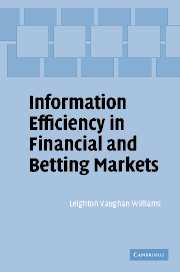Book contents
- Frontmatter
- Contents
- List of figures
- List of tables
- List of contributors
- Introduction
- Part I The concept of information efficiency
- Part II Selected readings
- 4 An assessment of quasi-arbitrage opportunities in two fixed-odds horse-race betting markets
- 5 The presence of favourites and biases in bookmakers' odds
- 6 Searching for semi-strong form inefficiency in the UK racetrack betting market
- 7 Models, markets, polls and pundits: a case study of information efficiency
- 8 Longshot bias: insights from the betting market on men's professional tennis
- 9 Biases and insider trading in exotic bets on thoroughbreds
- 10 On the improbability of information efficient parimutuel betting markets in the presence of heterogeneous beliefs
- 11 Modelling gambling demand in a laboratory casino: discovering the importance of individual-specific effects
- 12 Market efficiency of the 50–30–20–10 horse-racing spread betting market
- 13 Insider trading and bias in a market for state-contingent claims
- 14 Rationality and efficiency in lotto games
- 15 Efficiency of the odds on English professional football matches
- 16 Modelling distance preference in flat racing via average velocity
- 17 Testing for market efficiency in gambling markets: some observations and new statistical tests based on a bootstrap method
- 18 Information (in)efficiency in prediction markets
- Index
- References
11 - Modelling gambling demand in a laboratory casino: discovering the importance of individual-specific effects
Published online by Cambridge University Press: 09 July 2009
- Frontmatter
- Contents
- List of figures
- List of tables
- List of contributors
- Introduction
- Part I The concept of information efficiency
- Part II Selected readings
- 4 An assessment of quasi-arbitrage opportunities in two fixed-odds horse-race betting markets
- 5 The presence of favourites and biases in bookmakers' odds
- 6 Searching for semi-strong form inefficiency in the UK racetrack betting market
- 7 Models, markets, polls and pundits: a case study of information efficiency
- 8 Longshot bias: insights from the betting market on men's professional tennis
- 9 Biases and insider trading in exotic bets on thoroughbreds
- 10 On the improbability of information efficient parimutuel betting markets in the presence of heterogeneous beliefs
- 11 Modelling gambling demand in a laboratory casino: discovering the importance of individual-specific effects
- 12 Market efficiency of the 50–30–20–10 horse-racing spread betting market
- 13 Insider trading and bias in a market for state-contingent claims
- 14 Rationality and efficiency in lotto games
- 15 Efficiency of the odds on English professional football matches
- 16 Modelling distance preference in flat racing via average velocity
- 17 Testing for market efficiency in gambling markets: some observations and new statistical tests based on a bootstrap method
- 18 Information (in)efficiency in prediction markets
- Index
- References
Summary
Introduction
Gambling has become an important source of government revenue all around the globe at the local, regional and national levels. Governments seek to maintain, and where possible to increase, the inflow of gambling revenues. Gambling businesses operate with a profit maximisation objective and find increasing government taxation a serious threat to profitability. One way to approach the problem between firms and tax authorities is to first analyse how to increase the size of the aggregate pie to be divided between the two. The key variable of analysis is the aggregate house take-out percentage, since this is the essential element of the price of gambling from the perspective of potential consumers. Our analysis focuses on the question of how to set this take-out percentage so that the aggregate revenue collected from gamblers is maximised. However, the analysis presented in this chapter is useful for other policy purposes because it quantifies the demand curve.
Reduced consumption, in addition to the amount of revenue raised, is also of interest to certain government entities, particularly those concerned with social issues such as problem gambling, crime and other social ills that are sometimes seen to be negative externalities of legal gambling markets. For these other purposes, it is also worthwhile to have an estimate of the responsiveness of gambling demand to increases in the house take-out rate.
- Type
- Chapter
- Information
- Information Efficiency in Financial and Betting Markets , pp. 262 - 276Publisher: Cambridge University PressPrint publication year: 2005



